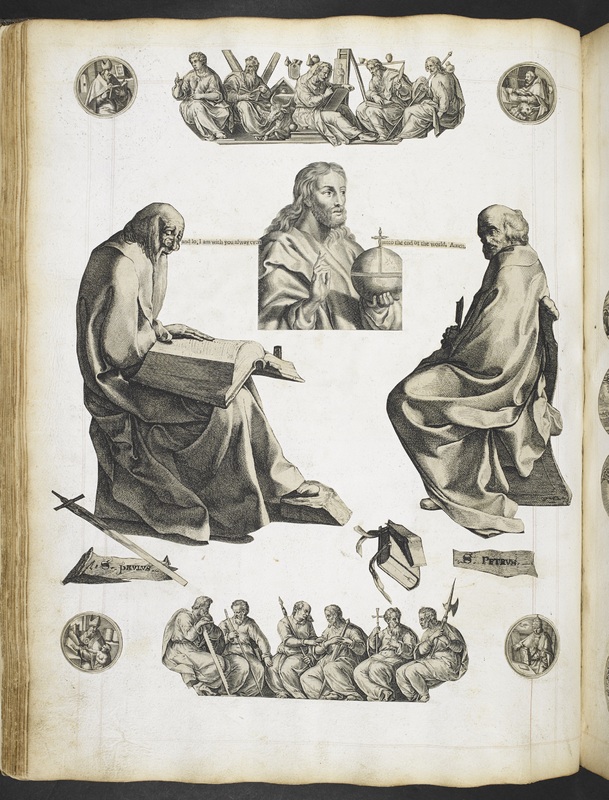Credits & Copyright
Background
This project began as early as 2011, when I (Whitney Trettien) began researching the harmonies made at Little Gidding as part of my dissertation. That dissertation on Little Gidding became one chapter in Cut/Copy/Paste: Fragments from the History of Bookwork (University of Minnesota Press, 2021), a hybrid print/digital book on boutique publishing projects in the seventeenth century and what they teach us about digital humanities today. This website was designed between June 2020 and September 2021 in collaboration with my co-editors Zoe Braccia and Penny Bee as a means of storing, sharing, and displaying the fruits of that research, from my early work identifying prints in the harmonies to later research on the evolution of Little Gidding's cut-and-paste method of composition.
Labor
Even as this project began from my research, this website simply would not exist without my co-editors Zoe Braccia and Penny Bee. They shared with me the burden of not only very tedious tasks, like copying, cleaning, and sorting metadata, but provided the curiosity and intellectual camaraderie necessary to transform a set of messy spreadsheets into beautiful maps of early modern creativity.
Zoe's specialty was sourcing and then finding digital images of even the trickiest prints. She is responsible for identifying most of the prints in the excerpts from the Pentateuch and finding facsimiles for nearly all of the engravings in the Cotsen Harmony.
Penny's specialty was identifying the source texts in the Houghton Harmony, and they are responsible for nearly every mapped fragment you see in that edition. Penny also researched and came up with an accessibility plan for the site, such that the color-coding we use can be seen even by those with certain forms of color blindness.
In addition, Emilie Friedman kindly provided help identifying and tracking down digital editions of the Cotsen pamphlet, at a crucial moment in the history of this project.
Zoe, Penny, and I are all together responsible for choosing Omeka and Neatline as our platforms, and for redesigning the text widget as a navigational schema for each edition. We took as inspiration Cassidy Holahan's digital edition of Sarah Waln Bulkeley's commonplace book, in which she uses Neatline to "map" each textual excerpt. We are grateful to Cassidy for this incredibly clever idea, and hope our own hack of Neatline honors the legacy of Little Gidding's creative interventions.
Funding
None of this work would have been possible without generous support. A Katharine Jefferts Schori Award from the Episcopal Women's History Project provided the funds to digitize the earliest gospel harmony at Houghton Library. Mellon Foundation funds distributed through the Digital Innovation Lab at University of North Carolina, Chapel Hill, and the Price Lab for Digital Humanities at the University of Pennsylvania enabled me to secure permissions to reproduce several photographs here and, most importantly, to pay my co-editors Zoe Braccia and Penny Bee for their work. Zoe's work has also been supported by the Center for Undergraduate Research and Fellowships at the University of Pennsylvania. An NEH-Mellon Fellowship for Digital Publication granted me the research time necessary to complete this site.
Images
The British Library has kindly granted me permission to reproduce six photographs (three page openings) of the King's Harmony (C.23.e.4), here and in the accompanying print book, as well as the Acta Apostolorum and The Revelation of S. John the Divine (C.23.e.3) in its entirety on this site. I'm very grateful to Christian Algar, Mia Ridge, and Louise Ashton for facilitating these permission requests.
The Royal Library, part of the Royal Collection Trust (© Her Majesty Queen Elizabeth II 2021), has also kindly granted me permission to reproduce images from Prince Charles's Pentateuch concordance on this website. You can learn more about this remarkable item via the Royal Library's own quite thorough digital exhibit. I am grateful to Karen Lawson for facilitating this permission.
I reproduce images from Houghton Library at Harvard University and the Cotsen Children's Library at Princeton University under their own policies allowing reproduction for academic purposes. I am grateful to John Overholt and Andrea Immel for allowing me to study these books so thoroughly (and carefully!) in person, and for fielding my questions about them over the years.
Copyright
All original intellectual content and design on this site is licensed for reuse under a Creative Commons Attribution-NonCommercial 4.0 International license, meaning that you are free to adapt, post, reuse, and remix this content for noncommercial purposes as long as you cite this site.
Citation
To cite this website, please use the following information (in your chosen format):
Penny Bee, Zoe Braccia, and Whitney Trettien, eds., Little Gidding Harmonies (2021), digitalbookhistory.com/littlegidding.
